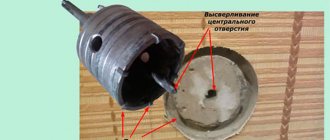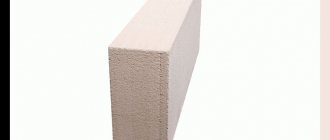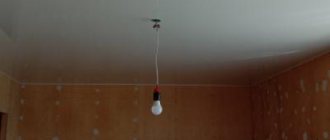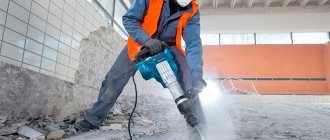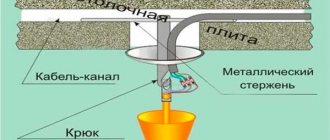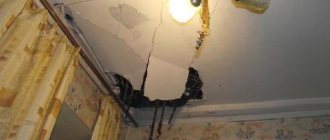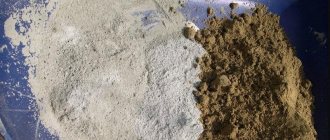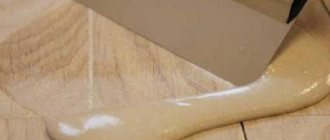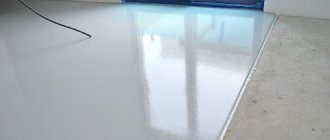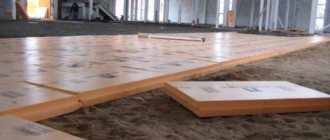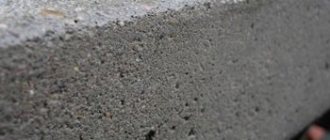Most modern high-rise buildings are constructed from monolithic concrete blocks, since this material is considered the most efficient, durable and relatively inexpensive. Owners of apartments in such buildings sooner or later need to carry out repairs and improve their everyday life. In this case, it is impossible to do without drilling holes in the walls to install a lamp, cabinet, painting or other interior and design elements. It is at such moments that the question arises of how to drill through a concrete wall and what equipment to use.
When carrying out renovation work, there is often a need to drill a hole in the wall.
Where does dust come from?
As a rule, hard materials are drilled with a hammer drill or impact drill. A drill, drill bit or other tool destroys the material and brings small particles to the surface. There is a special impeller inside the power tool. Rotating, it drives cold air towards the cartridge, cooling the engine and preventing the mechanism from clogging. However, the air flow disperses the dust to the sides, lifting it into the air.
Depending on the nature of the material, the dust will be more or less coarse. Homogeneity also differs: particles can have the same size or form several fractions.
The dust generated during drilling is hazardous to health. It can dust your eyes and get into your lungs when you breathe. To avoid such effects, it is necessary to wear a respirator, safety glasses and a hat when working.
Drilling concrete
Tools
To drill a reinforced concrete surface, you need to use specialized tools - in this case, you won’t be able to get by with a homemade tool.
Depending on your preferences and the diameter of the hole, you can use a hammer drill or a small electric hammer drill. The first option has less power, but at the same time has less weight and a convenient design. The hammer drill, accordingly, has greater potential, weight and dimensions.
Note! Since the use of construction equipment is often one-time in nature, it is more rational to rent them. Considering that their price is quite high, this way you will save a considerable amount of money.
In addition to the existing tool, it is necessary to purchase special drill bits that allow you to work with a concrete surface. For a hammer drill, drills with a Pobedit tip are selected.
The hammer drill has its own set of impact attachments, which, in most cases, are quite sufficient. As additional components for a hammer drill, you can also use drills with a tip.
Concrete drills
To form holes with a diameter of 35 to 120 mm, crown bits are used, which have Victory teeth - with their help, grooves for sockets, switches, etc. are drilled. If you are wondering whether it is possible to drill concrete with a screwdriver, then there are also tungsten carbide coated bits for this purpose. However, it should be noted that they are only suitable for units with a power of at least 1 kW.
Preparation
- Before drilling into concrete, you need to prepare the available tools . First of all, the fixing cartridge is inspected for the presence of sand or other foreign elements - if any, they must be removed. For this purpose, you can use a clean, dry rag;
- The drill should fit into the groove freely so that you can feel that it has gone in all the way . This is a mandatory condition, failure to comply with which may render the tip unusable. If we are talking about a hammer drill, then the drill must be clamped as tightly as possible; in hammer drills, the clamping is carried out automatically;
- Before drilling into a concrete ceiling, you must protect your face with a respirator or plastic visor . When working with walls, the use of personal protective equipment is also desirable, although not so critical;
Drilling
The process of drilling concrete is not particularly complicated and consists only of the ability to work with the tool. When working with drills, you should combine the hammer mode with drilling.
If you use crown attachments, the impact mode must be turned off. The only possible problem during this process will be the reinforcement frame reinforcement that may get in the way of the drill.
Before drilling reinforcement in concrete, you need to change the tip for working with concrete to a regular metal drill and drill through the obstacle. It is important to remember to turn off the bumper mode before drilling into the concrete.
In addition to the above, there are also a number of useful tips that will help you achieve quality results.
- Non-professional construction tools are not designed for long-term loads, which should be taken into account when working with them. The case must not be allowed to overheat - on average, the period of continuous operation of the equipment is no more than 15 minutes, after which the mechanism requires cooling. These 15 minutes of inactivity will be quite enough;
- When drilling, the drill becomes very hot and when a critical temperature is reached, the pobedit tip begins to deform. To cool the drill, simply immerse the tip in water - the more often you perform this operation, the less the consumables will wear out;
Why fight dust?
Dust is undesirable for many reasons:
- When dust enters the body, it causes health problems.
- Particles of cement or brick flour, getting into the gears of mechanisms, can damage them.
- When mixed with water, cement dust forms dirt that is difficult to wash off.
Therefore, it is customary to combat dust during repairs with all available means. To protect eyes, hair and skin, the construction worker wears special clothing, safety glasses, a hat and respiratory protective equipment (respirator or gauze bandage). Furniture and other things that cannot be removed from the room during repairs are covered with newspapers or polyethylene.
Devices and power tools are produced in dust-proof cases. The index of protection against dust and water ingress (IPxx) will help you find out the degree of protection of the device from dust. If the device has the index IP5x or IP6x, it is not afraid of dust getting inside.
However, all these measures only reduce the damage. Devices that collect dust even as it forms can radically solve the problem.
How do professionals deal with dust?
Professional builders have in their arsenal a special tool to combat the resulting flour: an attachment on a drill or drill, to which a hose from a vacuum cleaner is connected. This addition to the hammer drill helps collect garbage very cleanly, but it has a number of disadvantages:
- You have to spend money to purchase a nozzle. Such expenses are appropriate if you have to drill constantly. But if you occasionally have to drill one or two holes in the ceiling or wall, it is irrational to buy a special nozzle.
- As a rule, using the nozzle requires the help of a partner who will hold the vacuum cleaner. In everyday life, improvised do-it-yourself devices are used to solve the same problems.
Holes for lamps before ceiling installation
During the installation of a tensile structure, the issue of installing lighting fixtures for the room must be resolved. If this topic is raised before the ceiling is installed, it will make it possible to plan the presence of the necessary holes in the tension covering for lamps, and at the same time avoid the problems and difficulties associated with making such openings.
Important! Installation of lamps directly into the tension covering is not provided. To do this, special rings are installed to protect the fabric from overheating and melting.
First of all, it is necessary to correctly mark the installation locations of the lamps on the base ceiling. This will help to create openings of the required size in the tension covering. During marking, the dimensions of the lamps themselves and their power ratings are also taken into account. After marking is completed, mortgages are installed, which are sold in specialized stores, but you can also design them yourself.
To install the mortgages, according to the diameter of the purchased lamps, you will need rings that are attached to the ceiling using hangers used in suspended plasterboard ceilings. The thickness of the rings is 5-10 mm. You can make them yourself by cutting them out of plastic, or buy ready-made ones without spending time on their production.
The next step is to adjust and correct the location of the rings and connect the wiring to them, because this stage allows for adjustments to the placement of the rings and the length of the wire. It is also recommended to check the functionality of the luminaires, because after the covering has been tensioned, troubleshooting is problematic and difficult.
When the preparatory work is completed, you can begin the main actions related to the openings on the canvas for lamps:
- We install the tension fabric on the frame. We feel the rings under the canvas and mark these places with a marker.
- Next, you will need thermoplastic rings, which you can also cut yourself or, to save time, buy ready-made ones at a hardware store.
- We glue rings coated with glue to those places on the canvas that were marked with a marker.
- Then holes are carefully cut into them along the inner perimeter using a sharp knife.
- A lamp is mounted in the resulting hole.
Homemade dust control devices
Improvised devices sometimes cannot boast as complete dust removal as professional vacuum cleaner attachments. But they are much cheaper and often do not require assistance during use.
Drill attachment from a bottle or cup
If you need to drill a hole in the ceiling, the crumbled concrete will mostly fall down. To collect dust, a combination of a drill or auger and a bottle with a cut off bottom will help. An ordinary plastic cup will do, but it will need to be cut so that the part of the drill that will go into the wall protrudes above the walls. As a result, the “flour” falling down will fall into the cup and will be easy to remove.
Moistened sponge
You can make a nozzle from a sponge:
- the center is measured on it;
- draw a circle with a diameter of about 5 mm in the center;
- cut the foam rubber in a circle with a stationery knife and remove it to a hard substrate;
- a hole is made in the substrate into which a drill is inserted;
- Before starting work, moisten the sponge with water.
Like the previous device, this option is more effective if you need to drill the ceiling rather than the wall.
Paper envelope
An envelope made of thick paper is attached to the wall under the place where the hole will be drilled with double-sided tape. You can make it yourself by bending the sheet in half and staple it along the edge. The garbage will fall down, collecting in the envelope. Instead of an envelope, you can glue a paper cup.
The main disadvantage of this method is that light dust blown to the sides is not collected.
We use a vacuum cleaner
You can use the vacuum cleaner even without a special attachment.
- The easiest option is to draw in air with the narrowest slot-shaped nozzle. It creates a very powerful stream that draws in flour particles well. The disadvantage of this method is that you need an assistant.
- The second option is to build a nozzle from a plank with a drilled hole and a collection from a cut bottle attached to it. Then the drill is inserted through the holes in the bottle and the board, and the vacuum cleaner is connected to the neck.
We hope that the proposed methods will help you complete all work related to drilling as cleanly as possible, without unnecessary dust and labor costs.
Rotary hammer with vacuum dust collector
A much more productive and modern way to drill concrete without dust is to use a hammer drill with a vacuum dust collector.
This new product was released by various well-known companies, for example, Bosch. The device works on the principle of a vacuum cleaner. During drilling, a vacuum dust collector sucks up all the dust.
Using the paper funnel method, you will never achieve this result, because some of the dust will still fly out over the edges of the funnel. This will not happen when using a hammer drill. If you do not want to overpay for a new product in the world of construction equipment, you will have to bear other costs - time for cleaning the premises.
Now you won’t have any questions about how to properly drill concrete with a drill. Using a hammer drill with a vacuum dust collector, you can calmly, without worrying about future cleaning, drill a hole in the wall and floor, not to mention the ceiling.
Concrete is the main building material from which most of all modern buildings are built. When renovating, a problem that often arises is how to drill into concrete? After all, reinforced concrete slabs are a material of increased strength, the processing of which requires knowledge and special tools. Below we will look in detail at how to quickly complete this procedure and what is needed for this.
How to drill into a concrete wall without dust and debris?
Many owners know how much cleaning there is due to dust and debris when drilling concrete or brick walls. How much do you have to move furniture, wash floors, wipe dust in a living space after drilling holes in the walls to install interior items such as shelves, lamps, paintings, etc.
One day my friend showed me an interesting way. For which I am very grateful to him. How to drill into a concrete wall without dust and debris? Maybe someone already knows this method or uses other devices, but I’ll tell you and show you anyway. So, everything in order.
Mark the space for the hole on the wall.
We make a small envelope-pocket device. To do this, take a sheet of A4 paper.
Fold a sheet of paper in the manner shown in the photos below.
Take masking tape.
We glue the tape so that we get an envelope in the form of an open pocket.
We glue the envelope on the wall as close as possible to the future hole.
We take a hammer drill with a drill of the required diameter. To better guarantee the cleanliness of the drilling, we take a household vacuum cleaner. After removing the brush attachment, apply the vacuum cleaner hose to the drilling site. Turn on the vacuum cleaner, preferably at full power. And drill a hole with a hammer drill.
You can call someone at home for help. But if there are no assistants, then in one hand you have a vacuum cleaner hose, and in the other hand a hammer drill. If the vacuum cleaner is powerful enough and the drilling diameter is small, then the envelope remains almost empty at the end of the job. Unfortunately noisy, but no dust or debris.
Take a dowel-nail. And hammer it into the resulting hole.
Attention! You need to peel off the envelope carefully and slowly, without sudden movements, otherwise you can damage the wallpaper.
Source: kladkan.ru
Too lazy to clean up later?
Is it possible without dust? A fairly adequate desire in this case is to simplify the process by eliminating dust after it’s finished, because hardly anyone enjoys cleaning. Yes, you can’t find anything on Aliexpress and Ebay, but nothing will save you money and amuse others better than making your own inventions.
A fairly common way to collect dust is to create a small envelope. Place it under the place where you will drill and take out the video camera to amuse your friends later.
One example of how the mind works is in the video below:
I will share my personal experience. More precisely, the experience of my father, who finds a sound solution in any situation. Before he starts drilling something, he takes a vacuum cleaner and calls someone who is closest. Further according to the algorithm.
- Before you bring the vacuum cleaner tube to the place where you will make the hole, turn it on.
- Use a vacuum cleaner to catch dust that falls on the floor during drilling.
- Don’t force anyone to clean up after you and don’t suffer from this process yourself.
Be careful in your work and happy in life. Best wishes!
Have you ever found yourself cleaning up dust and debris in a room after just one or two holes? Meanwhile, you can drill holes without dust.
Vacuum cleaner
The first thing that comes to mind is to use a device specifically designed for collecting dust. This refers to a regular household vacuum cleaner.
After removing the nozzle and placing the tube of the turned on vacuum cleaner as close as possible to the location of the future hole, start drilling. The vacuum cleaner will do its job flawlessly - almost all the dust will be drawn into its dustbin.
If drilling work is carried out frequently, it makes sense to get a nozzle with a special dust-collecting casing, especially since many manufacturers of tools and construction equipment produce such nozzles. In this case, all the debris from the hole is guaranteed to end up in the vacuum cleaner.
Envelope and other tricks
You can do without a vacuum cleaner; in this case, the role of the dust collector will be played by an envelope in the form of an open pocket of any size, which can be easily glued together from a sheet of paper.
Before drilling, secure the envelope to the wall under the future hole using masking tape. After drilling a hole, carefully peel off the envelope with the dust and debris collected in it from the wall. The floor under the hole in the wall and the surrounding area will remain clean.
You can get by with a postal envelope. To make it look like a pocket, insert one or two matches in the form of spacers in its upper part.
If you use a hammer drill or hammer in impact mode, it is recommended that instead of an envelope, glue together from paper something like a deep box without a lid, which, before starting work, is attached to the wall using the same masking tape.
If the hole is to be drilled not in the wall, but in the ceiling, it is better to use a cone-shaped envelope folded from a sheet of paper to collect dust.
When you drill into concrete or brick walls with a hammer drill or hammer drill, you usually end up covered in concrete or brick dust, but there is a very simple way to significantly reduce the damage to the surrounding area.
Take a sheet of paper, bend it almost in half, then fold it over and fold the strips on the sides to make an envelope. We glue it to the wall with masking tape under the place where we will drill.
Almost all the concrete dust during drilling is poured into an envelope. Very little gets past. One envelope can be used to drill all the necessary holes, and then simply thrown away along with the concrete dust.
From the comments to the post:
— My husband glues bags)
Or cardboard boxes from breakfast cereals)
— But what about Bosch devices like a wall-mounted vacuum cleaner?
Envelopes are too papery.))
- this option is ridiculous and ineffective... this envelope does not save you from clouds of dust in the air and from dusting the entire space of the room;
to avoid DUST IN THE AIR AT ALL, I always do this: I take an ordinary synthetic sponge, 3-4 cm thick, make a hole in the middle for a drill, moisten it with a little excess water, then tape it to the wall on both sides with the hole pointing to the point drilling and drilling; The dust doesn't fly away AT ALL.
If you can’t spoil the surface with tape, you’ll have to get someone to help and he will carefully hold this sponge with his fingers on both sides.
- and if you put your wife next to her with a vacuum cleaner, it will be absolutely clean! 
- Should I substitute the vacuum cleaner?
- He will die from the very dust that does not fall into the envelope. If we mean a home vacuum cleaner.
“We made a closed envelope right on the hole, and drilled through the top of the envelope, through the paper. In this case, the back wall of the envelope (which is closest to the wall) should be made of masking tape. So there are no traces left on the wallpaper or around it at all. This is critical when all the repairs have already been done, and expensive wallpaper has a texture. This is especially critical for bricks. Among other things, this method allows you to avoid leaving marks on the wallpaper from marking holes.
— Yeah, it’s always more convenient to apply markings on masking tape, and it’s very important when you drill a tile, the feather doesn’t come off.
- Even easier - spray shaving foam on the wall.
- Everyone knows this.
They also put all sorts of attachments from a plastic bottle on the drill.
— I usually use a suitable box, for example, I cut off the top half of a milk carton at an angle, and also glue it to the wall using the high side.
- use your wife with a rag, and this problem will cease to exist
- No...that's not how planes fly. Dust, that's why it's dust, to float in the air. And it’s not dust that will fall into the envelope, but sand. That sand that can be easily removed from the floor with anything. But the dust will remain in the air for years (I’m not afraid of this word) and will gradually settle on all surfaces in the apartment.
- and most importantly, do not forget to attach a small plastic mayonnaise jar to the drill when chiseling ceilings!
— Something similar was published in the journal Science and Life *twenty years ago.
— From the old Soviet book “1000 tips for tinkering enthusiasts.”
The desire to decorate the interior of a room with a painting, hang hanging shelves, cabinets, a lamp, a mirror, or mount a sports equipment often remains unfulfilled. This is due to the need to drill deep holes in the wall or ceiling. And the problem is not so much the lack of a hammer drill (the tool can be borrowed from neighbors or rented), but rather the fact that during operation, small particles of dust and debris fall on the face, scatter around the entire perimeter of the room, laying down in a thick layer on surrounding objects. So, after a small repair you have to do a general cleaning or first cover the furniture with a large film. To avoid unpleasant consequences, check out life hacks on how to drill without dust.
How to drill concrete without excess dirt Bookmark 2
Drilling concrete or brick is a simple matter. To do this, you only need a good impact drill and a drill bit with pobedit tips. Of course, you need to be mentally attuned to noise and dust. If you can put up with the noise, then dirty furniture, household appliances and carpets will not make anyone happy. There are two methods in the fight against dust: folk and progressive. Let's first look at the traditional method, which, frankly, only works when drilling holes in the ceiling. How to drill concrete without dust? An ordinary paper funnel attached to a drill helps to combat it.
Adviсe
Before drilling into a concrete wall, prepare a small container of water. It is necessary for periodic cooling of the drill, which may burst as a result of overheating.
When drilling into concrete, care should be taken to avoid overheating.
During the drilling process, you can get into metal reinforcement. In this case, change the Pobedite drill to a regular one (diamond-coated) and drill through the metal rod. If the location of the hole is not fundamentally important, move a few millimeters to the side and drill a new one.
Before you start drilling a surface, be sure to make sure that there are no hidden electrical wiring running inside, since damage to the power cable during drilling can lead to disastrous results. To do this, use a special non-contact device, which is usually made in the form of a screwdriver with a built-in LED. If there is a wire inside the wall, the light bulb will let you know.
How to make a paper dust collector
Materials and tools
- paper
- scissors
- scotch
How to drill concrete without dust using a dust collector
1. Cut out a blank from paper (see photo). There is no need to measure anything. Everything is done by eye, sometimes by trial and error.
2. Cut several strips of tape and stick one end to the edge of the table.
3. Take a drill, insert the drill into the chuck and wrap the paper around the chuck to make a funnel. The bottom of the funnel should be below the cartridge so that it remains stationary when it rotates. Tape the edges of the paper together.
4. Tape the funnel to the drill body. It’s easier to do this by using not one long strip of tape, but several short ones. You need to glue the strips of tape overlapping each other, so that there are no gaps through which dust could spill out.
This simple device will help you collect some of the dust when drilling holes in the ceiling.
Now let's look at a more progressive method: drilling concrete using a hammer drill equipped with a vacuum dust collector.
It is clear that such a solution will cost more than a paper funnel, but the result will be completely different. With such a tool, you can, without fear of dust, drill holes not only in the ceiling, but also in the walls and floor.
Source: remont.boltai.com
Recently I needed to make just one hole with a hammer drill in the wall for a dowel-nail.
I immediately remembered all the simple ways to avoid littering:
using a paper envelope attached to the wall with tape, and using a disposable cup.
These methods are time-tested, but I wanted to come up with an even more convenient way. By chance, the idea came to mind to use a sponge for washing dishes.
It has a number of advantages: it is accessible, reusable, holds dust well when wet, and serves as a kind of filter.
Drilling without dust
When drilling walls, especially the ceiling, flour and grains of sand from the drilled material scatter throughout the room. This happens because an impeller is installed inside the drill to cool the engine, which, rotating, sucks air into the drill body from the side of the handle, and throws it out heated in the chuck area. This measure makes it possible to make a drill of greater power with small dimensions and protect the drill mechanism itself from dust. And the question of how to protect your home from dust when drilling is left to the owner to decide. I present a simple design that allows you to drill without dust.
The drilling jig for dust-free drilling is a modified previous version, but the shelf is replaced by a part cut from a plastic bottle. A piece of 9-11 ply plywood measuring 80x150 mm is cut out, and a hole with a diameter equal to the diameter of the drill plus 1 mm is drilled at a distance of 30 mm from the edge along the center line. On the side where the sandpaper will be glued, a trapezoidal cut is made with a depth of 2-3 layers of plywood. The sample will serve as a kind of air intake during drilling.
A part is cut off from a plastic bottle so that the remaining part can be attached to the conductor. The width of the base of the conductor is selected based on the size of the bottle. I took a square bottle, but any 1.5 liter bottle will do. Insulating tape is wound onto the threaded part of the neck of the bottle until it reaches a size equal to the inner diameter of the suction pipe of the vacuum cleaner. When the bottle is bent, holes are formed to form the required configuration. We close them with pieces of the remaining plastic from the bottle and secure them with a stationery stapler. You can close them with tape. There is no need for tightness here. Gaps of a few millimeters will not matter, since the suction power of even a low-power vacuum cleaner is excessive.
Then, using a furniture stapler, the formed part of the bottle is secured along the perimeter of the end of the base of the conductor, on the side where the sandpaper is not glued. We make a hole in the bottle for the drill. It is better to use the melting method, since the edges forming the hole will become thicker and last longer. I melted it with a soldering iron. You can melt a hole with a nail heated on a gas stove until red.
We connect the vacuum cleaner, turn on the minimum suction power, and do test drilling.
The result will make you very happy. You will not find a single speck of dust in the circle or brick flour on the drilling surface!
The content of the article
Why does the question arise, how to drill concrete? Have you bought a new mirror or decided to hang a shelf in the hallway? Or maybe your child is a talented painter, and you want to put all his works in a frame and on the wall? Or did another reason arise to drive a nail into the wall of a panel or brick house? In general, everything is going to the point that you can’t do without drilling the wall.
Every owner knows how to drill concrete. If you have a drill and a drill bit, there shouldn't be a problem.
Making a fixture
Using a ruler, we find the center of the sponge and draw a circle with a marker, cut it out with a knife. For each sponge, the size of the circle will be different. So, for a large sponge it is 5 cm - this is enough for dust from drilling concrete or brick to remain there.
We make cuts in a circle to the bottom abrasive material and tear off the foam rubber from the backing.
In the center of the substrate, use a knife to make two cuts crosswise, 5 x 5 mm, under a drill.
Simple tricks
You can drill a hole in a wall made of concrete, brick or plaster or in a floor slab using a drill with a Pobedit drill bit or a hammer drill. To reduce the likelihood of fine particles spreading throughout the room, take the advice of professionals and find out how to drill a dust-free wall or ceiling:
Use a vacuum cleaner when working. In this case, you will need an assistant. While one person drills the surface, the second holds the hose without a nozzle in close proximity to the drill. Using a vacuum cleaner it is possible to collect flying dust, but this option is only suitable for making shallow holes if you have a partner;
Have you ever found yourself cleaning up dust and debris in a room after just one or two holes? Meanwhile, you can drill holes without dust.
The first thing that comes to mind is to use a device specifically designed for collecting dust. This refers to a regular household vacuum cleaner.
Drilling process
If you are not carrying out large-scale repairs, and you need to make several small holes to install a lamp or picture, then a regular electric drill with a hammer drilling mode is suitable for this work. It is necessary to prepare a strong metal rod or a special punch that will match the diameter of the hole. An ordinary household drill cannot drill through concrete even in impact mode with a properly selected drill. To do this, a punch is used, which is periodically inserted into the hole and, using a hammer, breaks the solid elements of the wall.
Video on how to drill a concrete wall:
This procedure is repeated until the hole depth matches the required one. If you are the happy owner of a powerful industrial drill, most likely, its power will be enough to do without a punch. It is worth noting that this method takes a lot of time and effort, but for several holes it is quite suitable. It is also necessary to remember that drilling concrete creates a significant load on the tool, and the drill must be stopped periodically to avoid breakage.
If you are undertaking major renovation work, you cannot do without a hammer drill. The hammer drill is specially designed for drilling heavy-duty surfaces and easily copes with drilling concrete. This tool makes it possible to use a large number of different attachments for drilling small and medium-diameter holes for sockets, switches or water pipes.
How to drill with a hammer drill without dust
When drilling a hole in concrete or brick with a hammer drill, a lot of dust is generated. When construction processes are underway, this does not bother anyone. If you need to drill a hole in a residential, clean room, this becomes a problem. Dust, especially brick dust, will ruin wallpaper, upholstered furniture and other interior elements.
In this article we will discuss how to work with a hammer drill without dust. Or how to neutralize it during work.
Drilling holes with a hammer drill without dust.
Drilling algorithm
How to drill a hole in a concrete wall, not forgetting to take into account the necessary points? To do this, you need to know the sequence of rules for performing these works:
- choice of drill (for a concrete surface - pobedit);
- preparing the wall with a metal detector for the absence or specific location of electrical wiring and communication elements (heating, water supply);
- decide on the tool: for holes with a diameter of 12 mm and smaller use a drill, for larger ones - a hammer drill;
- fix the drilling location and start working at low speeds, switching to impact mode only after the drill has reliably penetrated 2-4 mm.
If the work is carried out carefully and conscientiously, errors and injuries will not occur, and the walls will be equipped with the necessary functional openings.
Disadvantages when using a vacuum cleaner
Some people use a vacuum cleaner. This is a good option to avoid dust when drilling with a hammer drill, but not always acceptable. This device may not be at hand. It requires two people to operate it. One drills a hole with a hammer drill, the other holds the suction tube of the vacuum cleaner next to the working part of the drill. All dust is sucked into the vacuum cleaner. But you can’t handle this situation alone. It is inconvenient for one person to monitor two operating devices at the same time, holding their parts in the right places.
How to drill a wall without dust
To drill a wall with a hammer drill without dust, you will need two things: tape and a plastic bag, which are used for packaging.
It is preferable to use masking tape. Let's mark future holes on the wall in the right places. Place an open plastic bag under the mark on the wall with tape. It should be held in such a way that all the drilling dust falls inside it. You can drill carefully, the main thing is not to overdrive. Then the waste is poured into a bag.
As soon as you increase the speed of the hammer drill, some of the rot will be blown around by the air flow from the engine fan. If you hit it carefully, at low speeds, the process will go just fine. You will collect all the dust in a plastic bag. It can be used repeatedly.
An important point: the tape must be glued to the wall very tightly. Inadequate gluing will result in dust falling between the wall and the tape and staining the wallpaper.
How to make a hole in a suspended ceiling for pipes
If you intend to stretch the panel in the kitchen or bathroom, you should discuss in advance the installation of suspended ceilings around the pipes - the master will select installation options himself. But often the need to cut through the film fabric arises during or after work. There are three ways to get the job done, let’s look at each one.
First option:
- make cuts in the right places;
- cut holes according to the diameter of the pipe;
- close the pipe joints with special plates;
- cut the fabric at the end of the cut line with a cross to close behind the pipe;
- remove excess fabric and install the cover on the pipe.
In this case, the diameter of the hole in the plate should be at least 7-8 mm larger than the diameter of the pipe. Standard sizes of finished plates are 15.6-21 cm in length. Cutting the panel is done only after fixing it in a baguette, but you need to select a bypass plate to match the color of the ceiling or a white shade.
Important! The film canvas quickly “creeps” under your hands, so cutting it without experience is not recommended. It is much easier to call a specialist and entrust him with pipe contouring on suspended ceilings. The service costs from $2.
How to fill a hole and how to seal a hole in a suspended ceiling
Second option:
- cut the canvas in the right places;
- install a ring of a certain diameter inside the panel;
- secure the edges of the fabric or film with a ring;
- start the pipes.
The option is simpler and does not require any skills, but is used more often on fabric stretch ceilings. The ring is fixed with glue and pressed against the ceiling so that the connection is tight. The main thing is that the edges of the panel go inside the plastic element; the excess can be trimmed off. The ring is selected taking into account the diameter of the pipe plus 0.6 cm.
Third way:
- Before installing the film into a baguette, heat the material in the direction of the pipe location;
- pull the canvas moving towards the pipeline (use a harpoon);
- mark the center of the pipe placement;
- Apply adhesive at the gluing site;
- align the cut with the mark on the harpoon;
- glue the ring, lower the harpoon;
- press the ring to the base and hold until it sticks firmly;
- use a knife to trim the fabric along the line of the ring;
- cut a hole for the pipe with a cross;
- Tuck the ends of the fabric inward and glue;
- place the ring on the pipe.
This option is suitable for mounting a plastic ring on the inside of the PVC film. If a suspended ceiling is installed with a pair of pipes around it, use one ring for both pipes. And remember, the size of the plastic ring should be 0.6 cm larger than the diameter of the pipe.
How to drill a ceiling with a hammer drill without dust
Here the situation is more complicated. You can apply the same construction as described in the previous paragraph. But the effect will be worse. As an option, we use a disposable plate or a disposable plastic container, pierced in the middle with a drill. If you don’t increase the speed too much, then most of the debris when drilling the ceiling will end up in this additional element. During operation, this plastic part will need to be held with your hand to avoid its rotation.
Drilling with a hammer drill without dusting the ceiling.
The best option in this case would still be a vacuum cleaner.
In general, decide how to operate a hammer drill without dust in accordance with the situation.
